– Edited to add:
During to a flood that hit my house, the fabrics and partially completed costume parts were destroyed.
So until I decide to actually redo everything with new fabrics, the pages for this gown only serve as a documentation and memory of what I made; not as a dress diary.
When studying the portrait, I came to the conclusion that the gown consists of the following parts and materials:
- The slashed orange „Over“-Doublet
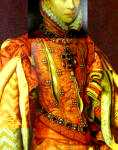
The doublet is worn over another garment, which I will describe in #3.
It is made of a satin finish, yet very stiff orange fabric, lined with an ivory fabric of likely texture. Isabel must have liked that color scheme a lot, as it also appears on one of her other portraits:

The doublet is lengthwise slashed,

which reminds me much of a portrait of Queen Elizabeth I. (this also applies to the shoulder- and waist treatments as well as the bias hemmed slashes, in this case – and note the likeliness in pose to the above shown portrait of Isabel with the orange gown):

Isabel’s doublet is also embroidered with what seems to be finest pearl decorations and golden threads – though the very small pearls could, of course, also be french knot embroideries carried out in silver thread, but I have never seen anything likely in any other portrait. Additionally, it’s decorated with what seem to be golden buttons with four pearls, arranged in a square shape.

The embroidery pattern for the small pearls or french knots and the golden thread seems to be repeating and could look like this:

(red dots indicate pearls, black lines indicate golden threads, or perhaps couched cording with a *very* fine cord)
for the doublet. The embroidery on the skirt front is a little more ornate, but basically also has this particular pattern.It has tabbed skirtings around the waist seam.
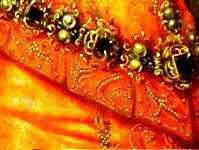
The doublet is lined with what seems to be the same fabric as the outer fabric – a satin finish fabric – just in ivory color. If I’m not too wrong, I can see stitching painted along the inside of those slashes, indicating how the lining was attached inside the slashes.

The shoulders are decorated with tabs of the orange, pearl- and golden thread embroidered satin material. They’re lined with ivory material; this can clearly be seen on the right side, where one of the tabs is turned upwards and reveals its lining.


The standing collar is very high and also decorated with what seems to be slashed piping of the orange material, decorated with pearls and golden threads.
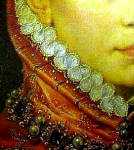
- The slashed orange spanish sleeves

The slashed sleeves are obviously the most interesting item of this outfit, as I have never seen anything just likely in any other portrait.
They are made of the same fabrics as the orange doublet – a satin finish fabric, but too stiff for satin; orange on the outside and ivory on the lining side.
As the material is too shiny for taffeta but draping too stiff for satin, I would guess that the material has to be silk duchesse – the weave likely to brocade, but without any pattern.The interesting thing is that the slashes, even if they seem to run on the straight grain at first sight, run in fact on the bias of the fabric. This picture here shows it:
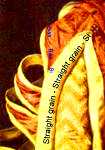
There are five slashes along the curved side of the sleeve, each of them being hemmed with what seems to be bias tape of the ivory lining or the turned over lining.

The „turned over lining“ theory could be verified by looking at the slashing edges, of which unfortunately only two are clearly visible in the portrait:

Those edges of the slashes are clearly round, not straight, and therefore indicate the possibility of some kind of „turned over hem“ along the edges of the slashes.
The wideness of those „turned over hems“ could be concluded by comparing the size of Isabel’s fingers with the breadth of the hem:

The hems are about as broad as one of Isabel’s fingers. If I would assume that Isabel’s fingers are fine and long – the fingers of a noblewoman – I would get to the conclusion that each of those turned hems is about 1.25cm (1/2 inch) wide.I am not certain if there would have to be some kind of ’support‘ on the backside of the sleeves for the slashes, which would not be visible in the portrait as the backsides of the sleeves are, well, behind Isabel’s back – some kind of strip which holds the slashes together downwards or something like that, so that they keep ’standing‘ like this – or if that effect is just produced by the material (could there be another stiff interlining in the slash strips which helps to keep them in shape?).
There is also the possibility that the middle back of the sleeves is not slashed at all, but that the sleeves are ‚just‘ slashed on either side (inside and outside), but I have a problem believing this as on the bottom, where the aglets are, the sleeve is most definitely split.
I think I will have to test what they look like with or without any kind of support; be it a strip or stiff interlining…The sleeves are embroidered in a likely manner as the orange doublet, but it seems as if they were just embroidered along the wrist- and outer curved area.

They also have golden aiglets- and ivory points decorations along that curved outside.
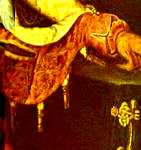
Another interesting thing is the fact that Isabel is wearing the slashed sleeves over her wrist on the left arm, but the right arm is free from the slashed sleeve, of which the wrist part is cut as rounded tabs. The sleeve closes around the wrist with what seems to be round metal buttons, at least two of them – on the front- as well as on the backside of the wrist; this can clearly be seen on the right sleeve (left picture below).
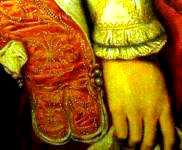
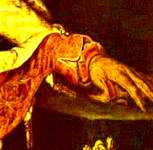
- The white „under-“ doublet, decorated with golden trims

There is another garment worn under the orange doublet which seems to be another white doublet; though this could of course also be fake (as in the meaning of some kind of „lining“, which just pretends to be a full doublet under the orange, slashed one).The one thing which indicates that this could be a full doublet is that the neck ruff along Isabel’s neckline seems to belong to that particular garment; at least the colors (ivory with gold) let me think so.
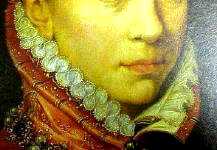
This „under doublet“ or lining is decorated with golden braids – just like the sleeves, it is highly likely that this golden braid decoration is arranged in a zigzag pattern, but this can not safely be said by what is visible of that bodice in the portrait. It may be possible that it is also pinked, like the sleeves; but I can’t recognize this in the pictures I have.

- The white, scored undersleeves, decorated with golden trims

The white, narrow sleeves, which seem to be made of the same ivory, satiny fabric as the orange doublet’s and sleeves‘ lining are pinked and decorated with golden braids in a zigzag pattern, just like the doublet.

The wrists have decorations of what seems to be tabbed strips of the ivory material, decorated with the golden braid.
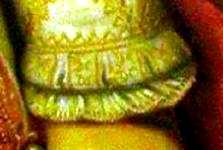
- The slashed skirt
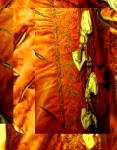
The slashed skirt is made of the same orange satin material as the doublet and spanish sleeves. It is slashed with some kind of ‚basket weave‘ pattern, the edges of the slashes obviously being sealed with wax, as they seem to be darker than the rest of the material.
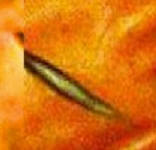
The front middle of the skirt is split, as it seems; the edges being decorated with the same pearl- and golden thread embroidery as the doublet and sleeves.
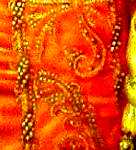
The front middle seems to be tied together with ivory points and golden aiglets, set in a distance of approximately 2-3 inches.

- The petticoat
I can just guess the petticoat by looking through the slashes of the orange skirt. But what I see through those slashes seems to be ivory material, and, in some places, glittering gold.
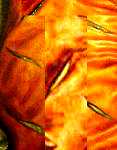
I think it’s almost safe to assume that the petticoat is made of the same material (ivory, satin fabric) and decorated in the same way (golden braid in a zigzag pattern) as the ivory undersleeves and the „under“ doublet. - The heavy, pearl-decorated headdress
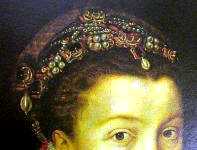
Isabel is either wearing a pearl hair net with heavy jewel decoration along the border, or a pearl hair net with another tiara or banding which is decorated with jewels.What I can’t figure out is what that „shadow“ behind and around her head could be, in the following picture marked with a red outline.
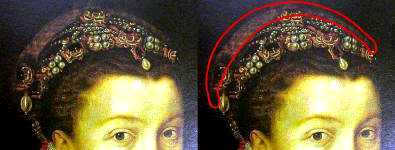
After studying the gown for some time, I had to decide how I want my gown to be. This is why I have made an extra page for the ‚planning of my gown‚.
Sorry, you are wrong about the color.
This costume isný orange, in fact is red (this is absolutly clear after the restoration of the painting)
Isabel is wearing her wedding dress; Spanish princesses and other princesses who married Spanish princes or kings wore that color. Because it was the dynastic color of Spanish crown.
This dress is cataloged as a crimson velvet gown richly ornamented, who was among the most lavish garments wardrobe of the Queen. In fact, at his death, was priced at 50,000 maravedis.
http://www.flickr.com/photos/odisea2008/4231427699/sizes/o/in/photostream/
https://www.museobilbao.com/uploads/exposiciones/exposicion-2-800-194.jpg
The two versions of the portrait (painted one by Sanchez Coello and the other by Antonio Moro) are owned Várez Fisa collection
Also it is noteworthy that the pattern of the dress is made by the Spanish fashion canons, not the French and certainly not to the English.
You can see details in other paintings by Coello as this:
http://www.museodelprado.es/uploads/tx_gbobras/P01142.jpg
or in other version os the same portrait:
http://www.gogmsite.net/_Media/portrait_of_elizabeth_of_va.jpg
Okay,
let me start by saying that this picture you posted as evidence for it being red is a sketch from the book „Costumes de femmes du pays de Caux et de plusieurs autres parties de l’ancienne province de Normandie“ by Louis-Marie Lanté, painted in 1827. In no way, shape or form can a sketch of the painting from 1827 be considered a source for the correct color of the gown; I guess you will agree on that part.
The second picture, which I guess shows the restorated version of the painting, still doesn’t show a true red, but more a brick red (bordering to orange). Just for reference, this is what I would call „red“ without any orange tendency.
I also don’t think that it’s a velvet gown because of the way the fabric creases and shines. This isn’t something velvet would do.
I do agree that the gown clearly belongs to the Spanish fashion; but then again I haven’t written anything contradicting this opinion 😉
In fact, I even called the sleeves „slashed Spanish sleeves“ several times.
But… as I said… the partially finished costume was destroyed during a flood; and I currently have no plans to redo it.